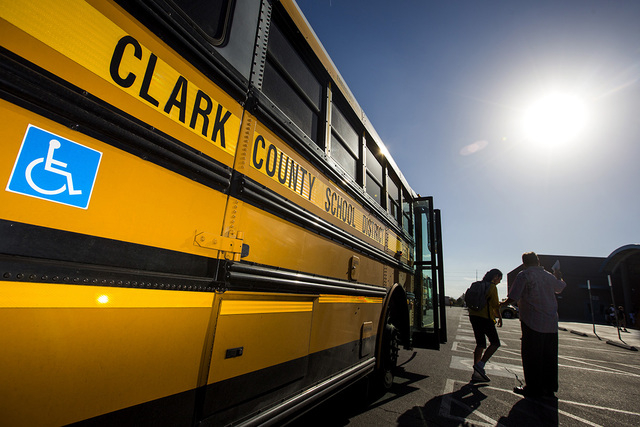CCSD expands magnet programs while planning to cut transportation
The Clark County School District has stirred a hornet’s nest with its plan to add seven new magnet schools next year, leading district officials to delay students’ application deadline to Feb. 3 while they piece together a way to calm swarming parents.
But the district hasn’t figured that out yet.
The problem is not the magnet programs, which offer students a chance to focus on a specialized field of study on top of the usual curriculum offered at schools.
Demand for more magnet programs is high. Nearly 16,700 students applied to magnet schools in 2014-15 with seats available for only a third of them. Magnet programs currently exist at 25 campuses, or 7 percent of the district’s 357 schools, with magnet students often outperforming their peers at traditional schools.
The expansion will increase the number of magnet seats by about 25 percent, or 5,000 students, over two years as the district adds programs to 11 existing schools and transitions four high schools to “select schools,” offering many Advanced Placement courses and specific programs of study.
The problem is transportation, which the district plans to greatly reduce in the midst of the magnet school expansion to cut busing costs by more than $30 million, according to district calculations. But the change in transportation might also help persuade students into the new but unproven programs.
About 8,570 magnet seats will be up for grabs next school year, and proposed plans would restrict school buses to only those students choosing to attend the closest campus offering their desired magnet program. In the case of Melissa McGill’s son, Vaughn, that would force him into Eldorado High School’s new science, technology, engineering and mathematics program if his parents can’t afford to drive him every day to Clark High School, which he’s dreamt of attending since he memorized the periodic table in third grade.
Up to now, Clark High School and the district’s other magnet schools — with the exception of career and technical schools — have provided school buses to all students no matter where they lived in the valley.
“My child has worked really hard with a specific goal in mind,” McGill said of her son, now an eighth-grader in Hyde Park Middle School’s math and science magnet program. “Everything is up in the air. The kids (at Hyde Park) are very upset.”
While Eldorado’s magnet program starts from scratch next year, Clark’s has existed since the 1993-94 school year and earned national recognition, producing 14 national merit semifinalists last year, more than any Nevada school, for the second consecutive year, according to the National Merit Scholarship Program competition, which honors the top 1 percent of America’s high school seniors based on their PSAT scores of the previous year.
“The programs are already there and working. Why mess with it?” said McGill.
The addition of all these magnet programs serves a few purposes. First of all, it could aid the district in expanding its short list of high-performing schools, which currently consists of those campuses with magnet programs and few others.
“We have schools doing an amazing job,” said Jhone Ebert, the district’s chief innovation and productivity officer.
It would also help alleviate crowding by pulling students from schools — mostly elementary schools — with too many students and relying on upwards of 20 portable classrooms in some instances.
But cutting bus transportation to new magnet students will undo one of the great benefits of these schools, said McGill. The original purpose of these magnet programs: diversifying urban schools that reflect the high minority, high poverty nature of their neighborhoods.
“Eliminating the busing does make it elitist. It really does,” said McGill, noting that she can probably afford to drive her son every day, but many of his friends don’t have that option.
Ebert contended that the transportation zones created by the duplication of many magnet programs will still be large enough to draw from various socioeconomic backgrounds, maintaining the diverse nature of magnet schools.
She noted that the district has agreed to continue busing all returning magnet students until they finish their magnet programs. The plan is to only limit transportation for new magnet students, which could affect up to 8,570 students. However, new students who are siblings of existing magnet students will be transported if there is room, Ebert said.
So, what will those thousands of new magnet students do if they want to attend the more distant magnet program?
In light of parents’ protest, the district is working on alternatives used in other urban districts.
Ebert said the district is in talks with the Regional Transportation Commission of Southern Nevada to possibly provide city bus passes for students, at no cost. School busing could continue if families pay a fee.
Or parents may be left to their own devices.
Ebert said the transportation plan will be finalized by the end of January. Regardless of what happens, there will be more magnet schools and 2,740 new seats next year.
“The big thing is creating choice and opportunity,” she said.
Contact Trevon Milliard at tmilliard@reviewjournal.com or 702-383-0279. Follow @TrevonMilliard on Twitter.

















